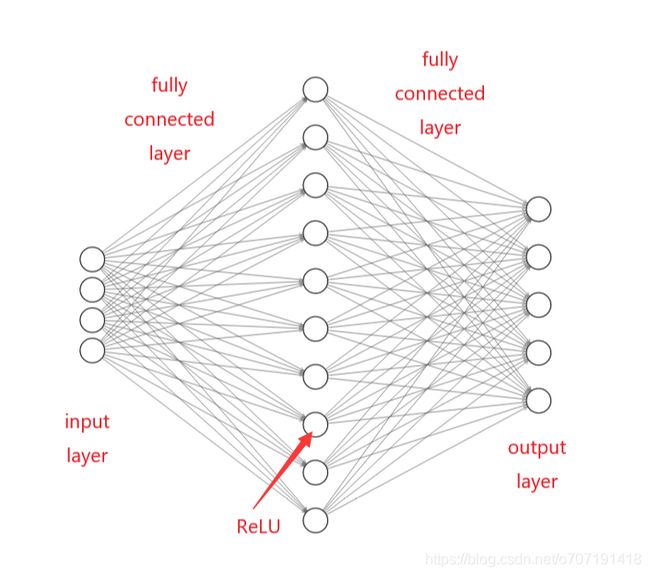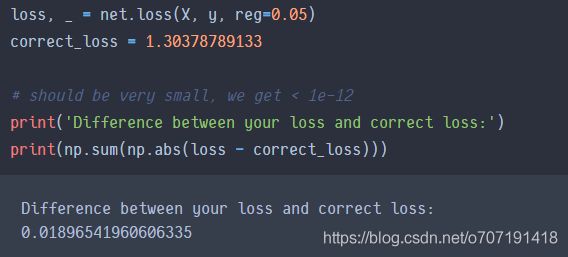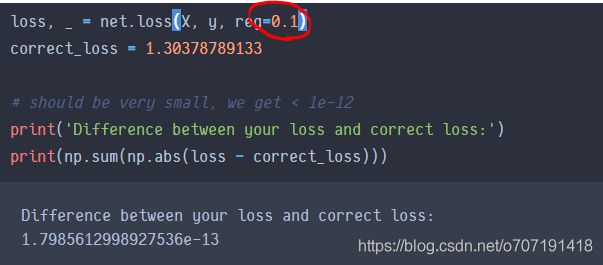Stanford-CS231n-assignment1-two_layer_net附中文注释
先记录一个很好用的画神经网络图的网站:http://alexlenail.me/NN-SVG/index.html
然后因为对神经网络的几个层的名字到底应该标注在哪有点疑惑,现在看了几段代码才弄清楚,所以标注在图上记录一下,如下图(激活函数以ReLU为例),如果错误欢迎指正
上图中的神经网络可叫做双层(应该是双全连接层)神经网络或者单隐藏层(one hidden layer)网络。网络的前向传播方式为输入节点与W1权重矩阵相乘并加上偏置b1,得到隐藏层的输入值,然后隐藏层的输入值需要经过ReLU函数处理,得到隐藏层的输出函数,然后再用输出函数重复上述过程,乘以W2权重矩阵并加上偏置b2,得到输出层的值。在这个过程中需要注意矩阵的维度方向,很容易颠倒出错,导致维度不一致无法相加或者相乘。
1. neural_net.py
1.1 Q1
第一个问题,在第一次求Loss的地方,出现了这个结果
我的代码每次跑都是0.018,感觉这个差值有点大了,然后去网上看别人的代码都是e-13级别的差值,然后在代码里找问题找了好久,实在找不出来错误,然后用别人的代码跑也是上面0.018这个结果,最后在这篇博客https://blog.csdn.net/kammyisthebest/article/details/80377613中看到,人家的reg都是0.1,我们的是0.05???然后reg改成0.1跑了一遍,果不其然
1.2 Q2
第二个问题,在求解神经网络反向传播的梯度代码中,遇到一个问题,求W1/W2的梯度都不难理解,但是求b1/b2的梯度时候就遇到问题了,首先代码中前向传播是这样写的
# 输入值与W1的点积,作为下一层的输入
z2 = X.dot(W1) + b1
# 激活函数,求得隐藏层的输出,也就是ReLU
a2 = np.maximum(z2, 0)
# 隐藏层的输出进入到输出层
scores = a2.dot(W2) + b2这样乍得一看,好像b1/b2的偏导数都是数字1,这导致我第一次写b1/b2的时候直接把偏导写成了np.ones_like(b1/b2),后来想想,不对啊,这只是在代码中用numpy库的简化写法罢了,实质上应该这么写
# 其实偏置本来也应该是一个矩阵,但是在Numpy的计算中直接被简化了
z2 = X.dot(W1) + np.ones(N).dot(b1.reshape(H, -1)) # 只是表达这个意思,代码不一定能跑
a2 = np.maximum(z2, 0)
scores = a2.dot(W2) + np.ones(N).dot(b2.reshape(C, -1))也就是说在求b1/b2的偏导数时候,实质上求导应该得到的是一个np.ones(N)这么一个向量,然后再根据cs231n中的求导法则,用上游传回来的偏导值乘以本地函数值,就可以得到梯度,也就是下面的代码
# 先求出输出层softmax型的loss func对输出层的偏导数,作为反向传播的起点,此处与SVM相同
# softmax公式为L=-s[yi]+ln(∑e^s[j]),可以求得L对s[yi]的偏导数为-1+e^s[yi]/∑e^s[j],也就是下面代码中的-1+prob
# 由于输出层的z和a是相同的值(即a==z),所以此处delta(L)/delta(a) == delta(L)/delta(z)
output = np.zeros_like(scores)
output[range(N), y] = -1
output += prob
# 先根据反向传播的上层梯度乘以本地变量求出W2的梯度
grads['W2'] = (a2.T).dot(output) # 公式BP4
grads['W2'] = grads['W2'] / N + reg * W2
# 求取b2的梯度,方法同上
grads['b2'] = np.ones(N).dot(output) / N1.3 代码
from __future__ import print_function
from builtins import range
from builtins import object
import numpy as np
import matplotlib.pyplot as plt
from past.builtins import xrange
class TwoLayerNet(object):
"""
A two-layer fully-connected neural network. The net has an input dimension of
N, a hidden layer dimension of H, and performs classification over C classes.
We train the network with a softmax loss function and L2 regularization on the
weight matrices. The network uses a ReLU nonlinearity after the first fully
connected layer.
In other words, the network has the following architecture:
input - fully connected layer - ReLU - fully connected layer - softmax
The outputs of the second fully-connected layer are the scores for each class.
"""
def __init__(self, input_size, hidden_size, output_size, std=1e-4):
"""
Initialize the model. Weights are initialized to small random values and
biases are initialized to zero. Weights and biases are stored in the
variable self.params, which is a dictionary with the following keys:
W1: First layer weights; has shape (D, H)
b1: First layer biases; has shape (H,)
W2: Second layer weights; has shape (H, C)
b2: Second layer biases; has shape (C,)
Inputs:
- input_size: The dimension D of the input data.
- hidden_size: The number of neurons H in the hidden layer.
- output_size: The number of classes C.
"""
self.params = {}
self.params['W1'] = std * np.random.randn(input_size, hidden_size)
self.params['b1'] = np.zeros(hidden_size)
self.params['W2'] = std * np.random.randn(hidden_size, output_size)
self.params['b2'] = np.zeros(output_size)
def loss(self, X, y=None, reg=0.0):
"""
Compute the loss and gradients for a two layer fully connected neural
network.
Inputs:
- X: Input data of shape (N, D). Each X[i] is a training sample.
- y: Vector of training labels. y[i] is the label for X[i], and each y[i] is
an integer in the range 0 <= y[i] < C. This parameter is optional; if it
is not passed then we only return scores, and if it is passed then we
instead return the loss and gradients.
- reg: Regularization strength.
Returns:
If y is None, return a matrix scores of shape (N, C) where scores[i, c] is
the score for class c on input X[i].
If y is not None, instead return a tuple of:
- loss: Loss (data loss and regularization loss) for this batch of training
samples.
- grads: Dictionary mapping parameter names to gradients of those parameters
with respect to the loss function; has the same keys as self.params.
"""
# Unpack variables from the params dictionary
W1, b1 = self.params['W1'], self.params['b1']
W2, b2 = self.params['W2'], self.params['b2']
N, D = X.shape
# Compute the forward pass
scores = None
#############################################################################
# TODO: Perform the forward pass, computing the class scores for the input. #
# Store the result in the scores variable, which should be an array of #
# shape (N, C). #
#############################################################################
# *****START OF YOUR CODE (DO NOT DELETE/MODIFY THIS LINE)*****
# 输入值与W1的点积,作为下一层的输入
z2 = X.dot(W1) + b1
# 激活函数,求得隐藏层的输出,也就是ReLU
a2 = np.maximum(z2, 0)
# 隐藏层的输出进入到输出层
scores = a2.dot(W2) + b2
pass
# *****END OF YOUR CODE (DO NOT DELETE/MODIFY THIS LINE)*****
# If the targets are not given then jump out, we're done
if y is None:
return scores
# Compute the loss
loss = None
#############################################################################
# TODO: Finish the forward pass, and compute the loss. This should include #
# both the data loss and L2 regularization for W1 and W2. Store the result #
# in the variable loss, which should be a scalar. Use the Softmax #
# classifier loss. #
#############################################################################
# *****START OF YOUR CODE (DO NOT DELETE/MODIFY THIS LINE)*****
# 根据softmax的Loss函数定义来求该网络的Loss
# 先减去最大值防止数值错误
scores -= np.max(scores, axis=1, keepdims=True)
# 求所有得分项求自然指数
exp_scores = np.exp(scores)
# 求概率矩阵
prob = exp_scores / np.sum(exp_scores, axis = 1, keepdims=True)
# 取出分类正确项的概率
correct_items = prob[range(N), y]
# 根据softmax的loss func求loss
data_loss = -np.sum(np.log(correct_items)) / N
reg_loss = 0.5 * reg * (np.sum(W1 * W1) + np.sum(W2 * W2))
loss = data_loss + reg_loss
pass
# *****END OF YOUR CODE (DO NOT DELETE/MODIFY THIS LINE)*****
# Backward pass: compute gradients
grads = {}
#############################################################################
# TODO: Compute the backward pass, computing the derivatives of the weights #
# and biases. Store the results in the grads dictionary. For example, #
# grads['W1'] should store the gradient on W1, and be a matrix of same size #
#############################################################################
# *****START OF YOUR CODE (DO NOT DELETE/MODIFY THIS LINE)*****
# 先求出输出层softmax型的loss func对输出层的偏导数,作为反向传播的起点,此处与SVM相同
# softmax公式为L=-s[yi]+ln(∑e^s[j]),可以求得L对s[yi]的偏导数为-1+e^s[yi]/∑e^s[j],也就是下面代码中的-1+prob
# 由于输出层的z和a是相同的值(即a==z),所以此处delta(L)/delta(a) == delta(L)/delta(z)
output = np.zeros_like(scores)
output[range(N), y] = -1
output += prob
# 先根据反向传播的上层梯度乘以本地变量求出W2的梯度
grads['W2'] = (a2.T).dot(output) # 公式BP4
grads['W2'] = grads['W2'] / N + reg * W2
# 求取b2的梯度,方法同上
grads['b2'] = np.ones(N).dot(output) / N
# 将最后一层节点的误差反向传播至隐藏层
hidden = output.dot(W2.T)
# 考虑到ReLU函数的作用,可以知道只有在z2矩阵中大于零的部分才会被传递至后面的层中,这里求的就是ReLU函数的偏导矩阵
mask = np.zeros_like(z2)
mask[z2 > 0] = 1
hidden = hidden * mask # N*H,这里相当于求解出了how bp algorithm works那一章中的公式BP2
# 再从隐藏层反向传播至W1
grads['W1'] = (X.T).dot(hidden) # 公式BP4
grads['W1'] = grads['W1'] / N + reg * W1
# W1同理
grads['b1'] = np.ones(N).dot(hidden) / N
pass
# *****END OF YOUR CODE (DO NOT DELETE/MODIFY THIS LINE)*****
return loss, grads
def train(self, X, y, X_val, y_val,
learning_rate=1e-3, learning_rate_decay=0.95,
reg=5e-6, num_iters=100,
batch_size=200, verbose=False):
"""
Train this neural network using stochastic gradient descent.
Inputs:
- X: A numpy array of shape (N, D) giving training data.
- y: A numpy array f shape (N,) giving training labels; y[i] = c means that
X[i] has label c, where 0 <= c < C.
- X_val: A numpy array of shape (N_val, D) giving validation data.
- y_val: A numpy array of shape (N_val,) giving validation labels.
- learning_rate: Scalar giving learning rate for optimization.
- learning_rate_decay: Scalar giving factor used to decay the learning rate
after each epoch.
- reg: Scalar giving regularization strength.
- num_iters: Number of steps to take when optimizing.
- batch_size: Number of training examples to use per step.
- verbose: boolean; if true print progress during optimization.
"""
num_train = X.shape[0]
iterations_per_epoch = max(num_train / batch_size, 1)
# Use SGD to optimize the parameters in self.model
loss_history = []
train_acc_history = []
val_acc_history = []
for it in range(num_iters):
X_batch = None
y_batch = None
#########################################################################
# TODO: Create a random minibatch of training data and labels, storing #
# them in X_batch and y_batch respectively. #
#########################################################################
# *****START OF YOUR CODE (DO NOT DELETE/MODIFY THIS LINE)*****
# 加上replace=False时候提示Cannot take a larger sample than population when 'replace=False',即batch_size>num_train时错误,故去掉
random_index = np.random.choice(num_train, batch_size)
X_batch = X[random_index, :]
y_batch = y[random_index]
pass
# *****END OF YOUR CODE (DO NOT DELETE/MODIFY THIS LINE)*****
# Compute loss and gradients using the current minibatch
loss, grads = self.loss(X_batch, y=y_batch, reg=reg)
loss_history.append(loss)
#########################################################################
# TODO: Use the gradients in the grads dictionary to update the #
# parameters of the network (stored in the dictionary self.params) #
# using stochastic gradient descent. You'll need to use the gradients #
# stored in the grads dictionary defined above. #
#########################################################################
# *****START OF YOUR CODE (DO NOT DELETE/MODIFY THIS LINE)*****
self.params['W1'] -= grads['W1'] * learning_rate
self.params['W2'] -= grads['W2'] * learning_rate
self.params['b1'] -= grads['b1'] * learning_rate
self.params['b2'] -= grads['b2'] * learning_rate
pass
# *****END OF YOUR CODE (DO NOT DELETE/MODIFY THIS LINE)*****
if verbose and it % 100 == 0:
print('iteration %d / %d: loss %f' % (it, num_iters, loss))
# Every epoch, check train and val accuracy and decay learning rate.
if it % iterations_per_epoch == 0:
# Check accuracy
train_acc = (self.predict(X_batch) == y_batch).mean()
val_acc = (self.predict(X_val) == y_val).mean()
train_acc_history.append(train_acc)
val_acc_history.append(val_acc)
# Decay learning rate
learning_rate *= learning_rate_decay
return {
'loss_history': loss_history,
'train_acc_history': train_acc_history,
'val_acc_history': val_acc_history,
}
def predict(self, X):
"""
Use the trained weights of this two-layer network to predict labels for
data points. For each data point we predict scores for each of the C
classes, and assign each data point to the class with the highest score.
Inputs:
- X: A numpy array of shape (N, D) giving N D-dimensional data points to
classify.
Returns:
- y_pred: A numpy array of shape (N,) giving predicted labels for each of
the elements of X. For all i, y_pred[i] = c means that X[i] is predicted
to have class c, where 0 <= c < C.
"""
y_pred = None
###########################################################################
# TODO: Implement this function; it should be VERY simple! #
###########################################################################
# *****START OF YOUR CODE (DO NOT DELETE/MODIFY THIS LINE)*****
# 前向传播,求出输出值
z2 = X.dot(self.params['W1']) + self.params['b1']
a2 = np.maximum(z2, 0)
scores = a2.dot(self.params['W2']) + self.params['b2']
# 求出得分矩阵每一行最大值的索引,代表分类的类别
y_pred = np.argmax(scores, axis=1)
pass
# *****END OF YOUR CODE (DO NOT DELETE/MODIFY THIS LINE)*****
return y_pred
2. two_layer_net.ipynb
best_net = None # store the best model into this
#################################################################################
# TODO: Tune hyperparameters using the validation set. Store your best trained #
# model in best_net. #
# #
# To help debug your network, it may help to use visualizations similar to the #
# ones we used above; these visualizations will have significant qualitative #
# differences from the ones we saw above for the poorly tuned network. #
# #
# Tweaking hyperparameters by hand can be fun, but you might find it useful to #
# write code to sweep through possible combinations of hyperparameters #
# automatically like we did on the previous exercises. #
#################################################################################
# *****START OF YOUR CODE (DO NOT DELETE/MODIFY THIS LINE)*****
best_acc = 0
learning_rate = [1e-4, 5e-4, 1e-3]
regulations = [0.2, 0.25, 0.3, 0.35]
for lr in learning_rate:
for reg in regulations:
stats = net.train(X_train, y_train, X_val, y_val,
num_iters=1500, batch_size=200,
learning_rate=lr, learning_rate_decay=0.95,
reg=reg, verbose=True)
val_acc = (net.predict(X_val) == y_val).mean()
if val_acc > best_acc:
best_acc = val_acc
best_net = net
print('lr = ',lr ,' reg = ',reg, ' acc = ', best_acc)
pass
# *****END OF YOUR CODE (DO NOT DELETE/MODIFY THIS LINE)*****
昨天晚上跑的时候在val集上最高的准确率达到了0.527,但是最后的参数出错,好像因为learning_rate设置太大导致nan错误,不知道为什么0.527的best_net也没有保存下来,今天再跑,最高的准确率只有0.52了,
然后最终在test_set上的测试结果




